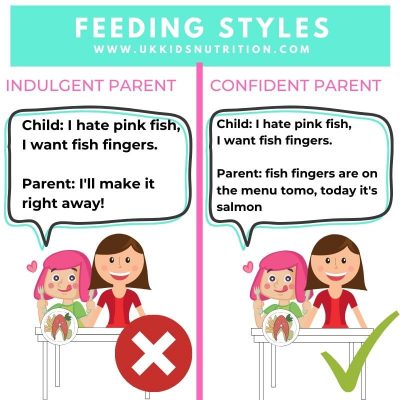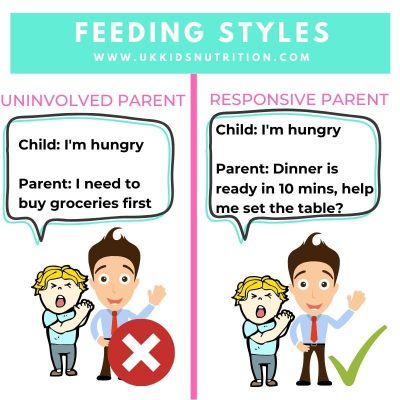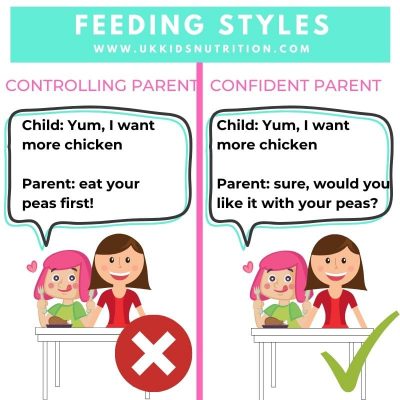Subscribe: Apple Podcast | Email | Spotify | Stitcher
Are meals stressful with your picky eater?
Are mealtimes with your picky eater stressful and a constant battle? Does your picky eater love high sugar foods or stick to eating only particular favourite foods? Is it an ongoing battle to get your child to eat nutritious foods?
Then you may need to start thinking about your feeding parental style!
There are four different feeding styles but only one style is successful at encouraging your child to try new foods.
Learn how to use a warm and nurturing feeding style to empower your child. Click on the play button on the media player above to tune into this podcast episode or keep reading to find out how to raise a healthy eater.
Here’s what you are doing well with your picky eater
Give yourself a pat on the back, because chances are, you are regularly preparing nutritious meals for your picky eater.
The problem isn’t with what you are dishing up, it’s how you are teasing and tempting your child to take a bite.
Spotlight on feeding styles – which one are you?
From work to pick-ups and then to rushing home to make dinner, there’s not a lot of time. I’m guessing that the last thing on your mind is how to lay out a beautiful table with serving dishes, platters and frills.
I get it. It’s easier to just portion everything out onto a plate and put it in front of your child, but how’s that working out for you so far?
If you want to influence your child to flirt a little with new foods then you’ve got to get the scene right. It’s a little like going out on your first date.
The mood, the environment, the smells and the appearance of the meal need to be just right. In fact, for a little person who might be afraid of trying something new or a portion of food that they are unsure about, the conditions must be perfect.
It’s all down to your feeding style.
There are four main feeding styles that you need to think about. Which one are you?
1/ authoritative/controlling – very much parent-centred, disciplinary style with rule-based demands regardless of the child’s food preferences. Strict rules around how much to eat, emphasis on completing meals and what to eat. The child doesn’t have much choice.
2/ authoritative/nurturing – warm, responsive to the child’s needs, supports the child’s eating using supportive and non-directive behaviours, nurturing and high in structure, demanding but responsive to the child’s needs.
This is the golden style. With this style note that it’s perfectly okay to have high expectations for your child’s diet and eating behaviour.
Your style will usually be combined with parental modelling, communication, negotiation and a warm emotional feeding interaction.
If your child generally looks forward to meals and is willing to try something new, then you know that you’ve nailed it.
3/ indulgent feeding style – there is no structure or routine to meals. The parent allows freedom to the child to eat when they wish. Preferred foods are always offered. The child is always offered a separate meal to the family meal.
4/ uninvolved – low demand with low responsiveness to the child’s needs.
As you flick through the list is there one style that resonates with you the most? Research shows us that the right feeding style can reassure children when seated at the table.
The goal of family meals is to help your child feel at ease, and ready for a happy relaxed dining experience that encourages a willingness to try new foods.
Severe picky eaters on the other hand may refuse to come to the table. They generally dislike eating and may have a small range of safe foods that they return to again and again.
In this scenario it’s perfectly acceptable to offer at least 1-2 ‘safe’ foods, the food they like/tolerate and foods that they have yet to like.

Who is a picky eater?
Not all picky eaters go on to become fussy adolescents and adults. In fact, picky eating is usually nothing to worry about, it’s developmentally perfectly normal hitting full force around the two-year mark.
However, once you add ongoing feeding problems with an unwillingness to try new foods or previously liked foods the child’s diet range becomes small.
As a result of very strong or limited food preferences, fussy eating can lead to a limited varied diet with vitamin or mineral deficiencies.
Over time, this can impact your child’s growth.
How to use the right feeding style
It’s a scientific fact: the way you eat or the feeding style that you adopt can influence the way your child responds to new foods.
The ‘how’ is a little more complicated but it doesn’t need to be if you are consistent.
It’s a combination of structure around meals, involving the child in the decision-making process around food choices as well as giving your child plenty of exposure and confidence to immerse in a variety of textures and flavours from an early age.
Add to the fact that if you are not eating regularly at the table, then I’d like to encourage you to do that every day from today.
If your child is dropping food groups like protein foods, fruit or vegetables then consider getting professional help.
Another sign that your child may be a severe picky eater is if he/she consistently refuses certain textures and coloured foods, or has very strong food preferences. You may need to chat with a specialist paediatric dietitian as your child is unlikely to “outgrow” the fussy eating stage without specialist support.

- Here’s what NOT to do at the table with your picky eater
- force feeding – this could damage your child’s relationship with food. He/she may become mistrustful and generally have a negative view of all meals.
- pressure to eat – it’s counterintuitive I know, but you’ve got to back off. Let your child choose what they want to eat even if it is just pasta yet again. Think about all those times when your child kept sneaking bits of food from your plate because no one was watching. Or the nursery and a school report that your child eats very well, but you have the exact opposite scenario at home.
No one likes to be pressured to do anything, your child is exactly the same. Even positive pressure can backfire as your child may end up overeating and consume more than their body needs just to please you. For this reason, listen to what your child is telling you.
- restriction of high-calorie foods – if everyone is tucking into ice cream but you are worried that your child has eaten too many ‘calories’, quality time is more important, let them join in. Besides, your child is simply going to view ice cream as an incredibly desirable food. He/she will assume that it’s something very special and will continue to desire it more.
- using food as a reward – I am not completely opposed to rewards (some experts may argue otherwise) but when used appropriately and considerably, it can work. However, do refrain from using food as a reward. For example, how many times have we fallen for the dessert trick? “Have another bite of xx food and then you can have pudding”. If you want to use rewards, then stick to non-food-related items or activities. I might say something like “girls, how are you getting on with dinner? Let me know when your tummy is happy so we can brush your teeth and start reading your new story book”.
Other maladaptive feeding styles could include seating the child in front of the disliked food until they agree to eat it or mixing and disguising foods.
Occasionally, I do cut vegetables into small pieces. It’s usually heading into a casserole or a saucy dish.
I would suggest letting your child know in advance what’s in the dish so that he/she is fully prepared and knows what to expect for dinner.
If your child usually deals with unexpected ingredients well, then you probably don’t need to make a big deal out of the individual meal ingredients.
On the other hand, if new textures and foods create anxiety, it’s really important to have regular chats with them regarding the menu.
Invite them to participate in the final meal by giving them a couple of options to choose from.

What you CAN do at the table with your picky eater
Desensitisation with messy play – if you have a fussy eater food based messy play is brilliant. Hiding toys in a bowl of pasta or rice, as well as rolling out dough or mince into balls is a fantastic activity for getting hands sticky and comfortable with wet textures.
For more ideas to tune into ‘The Best Messy Play Activities To Overcome Fussy Eating’.
Modelling – this is where family-based meals seated at the table are incredibly important. Here’s your chance to show a bit of bravery too. If you are usually a spinach hater, take your time to smell, lick and then taste a little bit of spinach. Describe the experience in a positive way to your child so that they can see that eating spinach isn’t so ‘yucky’ or frightening.
Feeding structure/routine – implement a structure around meals by offering main meals at roughly the same time each day. Include 1-2 snacks so that your child knows exactly when they can expect to be fed.
This also helps reduce anxiety around meals, particularly if they are not hungry at a particular meal. Your child will know that they can eat again at snack or the next scheduled meal.
Tip: make sure that you are practising Ellyn Satter’s division of responsibility by offering nutritious foods at meals and snacks.
Exposure – don’t forget that children sometimes need to be offered a disliked food at least 10-14 different times before they may be willing to try it. Occasionally you may need to offer it every day for an entire month so it’s a good idea to think about creative ways for serving the same food.
For example, if your children are getting bored with vegetables, can you steam them one evening, roast them the next and then stir-fry them with a delicious sauce to mix up the presentations?
Tangible rewards for tastes – I do believe in celebrating even the tiniest of wins. If your child tastes food that they previously disliked, then tell them how impressed you are with their bravery and willingness to try something new. Don’t just say “well done”, explain what pleased you about their behaviour.
You can reward their bravery with quality time together over a book or stickers if that’s what pleases them.
Anxiety reduction – oh boy, this is a big one! My advice to you is to try not to place so much emphasis on every mouthful of broccoli or the meat or whatever food your child has declared they hate.
Anxiety is a killer for appetites and can increase your child’s feeling of fullness earlier on less food. This will ultimately reduce the amount of food that your child is willing to eat. Focus on a positive feeding experience by playing music, talking about your day, or anything and everything but just not food!
Get your child involved – finally, get your child involved by asking them to choose which vegetables or main ingredient they’d like to eat that day.
You could ask “would you like broccoli or tomatoes for dinner tonight?” so that they have a choice between two different nutritious foods.
For more thoughts on the topic, dive into the podcast version of this blog post. The podcast is called ‘Healthy Eating For Kids’ or simply click play on the media play below.

Let Me Help
Would you like to meet a children’s dietitian who has successfully helped families solve their nutrition problems from around the world?
No matter what you are worried about, I’ll help you manage these with confidence.




2 thoughts on “How To Eat At The Table With Your Picky Eater”
you have great contents and amazing pictures. It was nice reading your contents thanks for sharing this information.
Have signed up for a consultation. Would love strategies when my child is not eating one important thing on his plate (nearly always protein). Do I ask him to eat half, ignore it completely? I always pressurise and prompt which ever works! Always turns into a battle